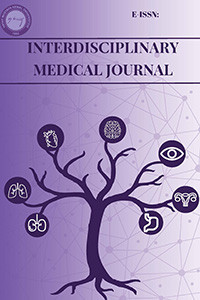APOPTOZİS
Apoptozis, Bcl 2, Bax, programlı hücre ölümü, ladder pattern
APOPTOZİS
Apoptosis, Bcl 2, Bax, programmed cell death, ladder pattern,
___
- 1. Alles A, Alley K, Barrett JC et al. Apoptosis: a general comment. FASEB J 1991; 5: 2127-8.
- 2. Pınarbaşı E. Apopitozis (Programlı Hücre Ölümü). Yıldırım A, Bardakçı F, Karataş M, Tanyolaç B (Editörler). Moleküler Biyoloji. 2. Baskı, Nobel Yayın Dağıtım. 2010:425-470.
- 3. Kerr JFR, Wyllie AH, Currie AR. Apoptosis: a basic biological phenomenon with wide-ranging implications in tissue kinetics. Br J Cancer. 1972; 26: 239-57.
- 4. Raff MC. Social control on cell survival and cell death. Nature 1992; 356:397-400.
- 5. Wright SC, Wei QS, Kinder DH, Larrick JW. Biochemical pathways ofapoptosis; nicotinamide adenine dinucleotide-deficient cells are resistant to tumor necrosis factor or ultraviolet light activation of the 24-kd apoptotic protease and DNA fragmentation. J. Exp. Med. 1996;183:463-471.
- 6. Gavrieli Y, Sherman Y, Shmuel A, Sason B. Identification of programmed cell death in situ via specific labeling of nuclear DNA fragmentation. The Journal of Cell Biology. 1992;119(3):493-501..
- 7. Ulukaya E.Apoptozis ders notları. Erişim: http://biyokimya.uludag.edu.tr/ apoptozisdersnotu, 04.05.2007.
- 8. Herrmann M, Kalden JR. Apoptosis and autoimmunity, Wiley-Vch Verlag GmbH & Co. KGaA, University of Erlangen-Nuremberg, Institute for Clinical Immunology, Weinheim, Germany. 2003.
- 9. Mcphie D L, Coopersmith R, Peralta AH, Chen Y, Ivins KJ, Manly SP, Kozlowski MR, Neve KA, Neve RL. DNA synthesis and neuronal apoptosis caused by familial alzheimer disease mutants of the amyloid precursor protein are mediated by the p21 activated kinase PAK3. The Journal of Neuroscience. 2003;23(17):6914–6927.
- 10. Piret JP, Arnould T, Fuks B, Chatelain P, Remacle J, Michiels C.Caspase activation precedes PTP opening in TNF-a-induced apoptosis in L929 cells. Mitochondrion.2004;3: 261-278.
- 11. Spector MS, Destroyers S, Haepener DJ, Hengartner MO. Interaction between the C Elegans cell death regulators ced-9 and ced-4. Nature 1997; 385: 653-6.
- 12. Güneş HV. Moleküler Hücre Biyolojisi. İstanbul Tıp Kitabevi.2010
- 13. Krajewski S, Krajewska M, Ellerby LM, Welsh K, Xie Z, Deveraux QL, Salvesen GS, Bredesen DE, Rosenthal RE, Fiskum G, Reed JC. Release of caspase-9 from mitochondria during neuronal apoptosis and cerebral ischemia. Proc Natl Acad Sci, USA.1999;96: 5752- 5757.
- 14. Tsujimoto Y. Role of Bcl-2 family of proteins in apoptosis, apoptosomes or mitochondria? Genes Cell. 1998; 3: 697-707 15. Shi YA. Structural view of mitochondria mediated apoptosis. Nos Struct Biol. 2001; 8: 394-401.
- 16. Xue L, Borutaite V, Tolkovsky AM. Inhibition of mitochondrial permeability transition and release of cytochrome c by anti-apoptotic nucleoside analogues. Biochem Pharmacol 2002;64:441-9
- 17. Pan TQ, Atkinson TP, Makris CM, et al. ALPS (autoimmune lymphoproliferative syndrome) associated with a mutation in Fas-Ligand. In: Programs and Abstracts of the 14th Annual Conference on Clinical Immunology and 5th International Symposium on Clinical Immunology. Washington; DC; 1999. p. 44.
- 18. Bell BD, Leverrier S, Weist BM, Newton RH, Arechiga AF, Luhrs KA, Morrissette NS, Walsh CM. FADD and caspase-8 control the outcome of autophagic signalling in proliferating T cells. PNAS. 2008;105:16677-82.
- 19. Yu L, Lenardo MJ, Baehrecke EH. Autophagy and caspases. Cell Cycle 2004;3:1124- 6.
- 20. Qian W, Liu J, Jin J, Ni W, Xu W. Arsenic trioxide induces not only apoptosis but also autophagic cell death in leukemia cell lines via up-regulation of Beclin-1. Leuk Res 2007;31:329–39.
- 21. Hara MR, Snyder SH. Cell signaling and neuronal death. Annu Rev Pharmacol Toxicol. 2007;47:117-41.
- 22. Kanoh M, Takemura G, Misao J, Hayakawa Y, Aoyama T, Nishigaki K, Noda T, Fujiwara T, Fukuda K, Minatoguchi S, Fujiwara H. Significance of myocytes withpositive DNA in situ nick end-labeling (TUNEL) in hearts with dilated cardiomyopathy not apoptosis but DNA repair. Circulation.1999;99:2757-2764.
- 23. Stassi G. Detection of apoptosis in tissues, Apoptozis, hastalıklarla ilişkisi ve güncel belirleme yöntemleri kursu. Dokuz Eylül Üniversitesi Sağlık Bilimleri Enstitüsü, İzmir; 2006.
- 24. Kültürsay H, Kayıkçıoğlu M.Apoptozis ve Kardiyovasküler Hastalıklar. Anadolu Kardiyoloji Dergisi.2002;4:323-329.
- 25. Murray RK. Cancer, Cancer Genes and Growth Factors. Murray RK, Granner DK, Mayes PA, Rodwell VW. Harper’s Biochemistry. Lange Medical Book. 1999.
- 26. Meng XW, Lee SH, Kaufmann SH. Apoptosis In The Treatment Of Cancer: A Promise Kept? Curr Opin Cell Biol 2006;18: 668-76.
- 27. Kaufmann SH, Gores GJ. Apoptosis In Cancer: Cause And Cure. Bioessays. 2000;22: 1007-17.
- 28. Fisher De. Apoptosis In Cancer Therapy: Crossing The Threshold. Cell. 1994;78:539- 42.
- 29. Fischer U, Schulze-Osthoff K. New approaches and therapeutics targeting apoptosis in disease. Pharmacol Rew 2005;57:187-215.
- 30. Green DG, Kroemer G. Pharmacological manipulation of cell death: clinical application in sight? J Clin İnvest 2005;115(10): 2610.
- Yayın Aralığı: Yılda 3 Sayı
- Başlangıç: 2023
- Yayıncı: Hatay Mustafa Kemal Üniversitesi Tıp Fakültesi Dekanlığı
ENSEFALOMALAZİK GÖRÜNÜMLÜ GLİABLASTOME MULTİFORME: OLGU SUNUMU
S. BAŞARSLAN, Cüneyt GÖÇMEZ, Abdülkerim GÖKOĞLU, Ahmet MENKÜ
Mustafa Özgür, Celalettin Dağlı, Fatma Ceylan, Harun Atıcı, Murat Karcıoğlu
Füsun AYDOĞAN, Erhan YENGİL, Nilgül ÜSTÜN, Raif ÖZDEN, Mehmet HELVACI
GEÇİCİ HEMODİYALİZ KATETER UYGULAMALARIMIZ
Ümit Halıcı, Mehmet Kayğın, Özgür Dağ, Hüsnü Limandal, Ümit Arslan, Adem Kıymaz, Ahmet Aydın, Bilgehan Erkut
Canan KAYA, Yasemin ÇALIŞKAN, Zafer YÖNDEN
SİSTEMİK RETİNOİD KULLANAN HASTALARDA İDRAR BULGULARININ DEĞERLENDİRİLMESİ
Emine Rifaioğlu, Bilge Şen, Özlem Ekiz, Mehmet Rifaioğlu, Asena Doğramacı
KLARİTROMİSİNE BAĞLI GELİŞEN AKUT PANKREATİT
M. ÇELİK, Mehmet DEMİR, Melda BULGURCU, Ali KARAKUŞ, Gamze KAVVASOĞLU
Ü. Daldal, Metin Atambay, T. Aycan, Neslihan Yıldız, Özlem Kaya
